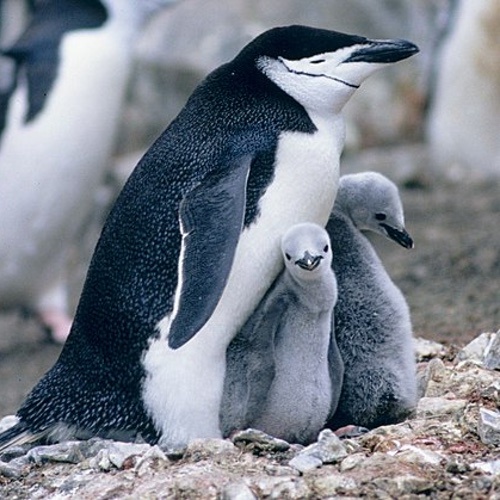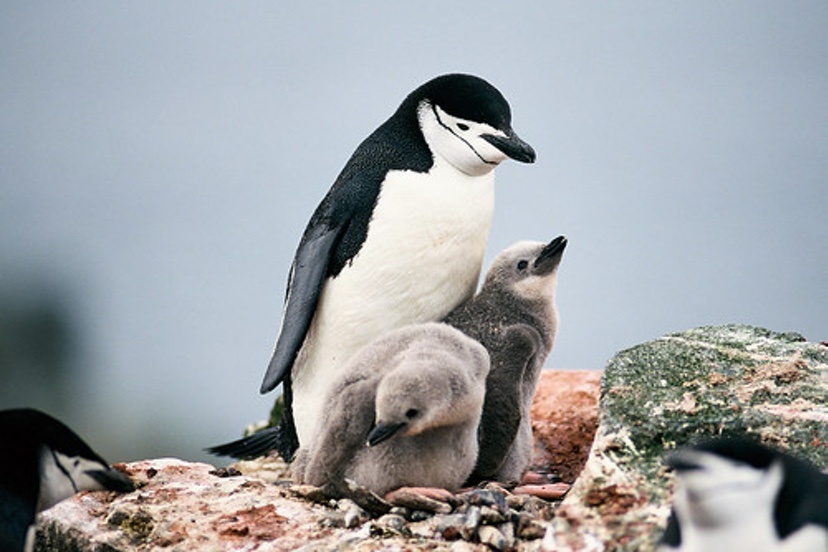Photo: A chinstrap penguin (Pygoscelis antarcticus) supervising some children, while yearning for a nap.
Sleep is a bit of an evolutionary mystery.
If you believe in evolution. Which many of us do, these days. Foolishly.
A sleeping animal cannot look for food, defend its territory, flee from danger, or find a mate. But still, the behavior known as ‘sleep’ is ubiquitous among animals. My cat, Roscoe, is a regular practitioner, for example.
Reportedly, laboratory animals will die, if cruelly deprived of sleep for an extended period. Something I can identify with, having been the parent of an infant human during certain periods of my life.
If we assume that looking for food, defending one’s territory, fleeing from danger, and finding a mate are the four main reasons for being alive, the existence of ‘sleep’ doesn’t easily fit with the standard theory that we evolved, based on ‘survival of the fittest’. It makes more sense, in terms of evolution, that the guy who can stay awake the longest would have a biological advantage over the lazy sleepyhead, especially in terms of finding a mate and keeping her entertained.
In spite of 4 billion years of supposed evolution, humans still fall asleep watching the Late Show and miss another chance to procreate. Makes no sense, from an evolutionary perspective.
The chinstrap penguin, meanwhile, has developed a rather unique relationship with sleep. Scientists recently discovered that these penguins engage in ‘power naps’ lasting about 4 seconds each — more than 10,000 such naps, per day — when they are nesting on King George Island off the coast of Antarctica. The parents take turns, sitting on the eggs or watching the kids, while the other parent goes fishing.
These numerous ‘micro-naps’ add up to about 11 hours of sleep per day.
Despite the common belief among sleep researchers that fragmented sleep is poor quality sleep, the penguins sail through their nesting activities with flying colors. The flock is healthy and successfully reproduces.
Which goes to prove, you can successfully reproduce, and still get 11 hours of sleep.
For their research, scientists from the French National Center for Scientific Research implanted electrodes into the brain and neck muscles of 14 penguins. For two weeks, they constantly recorded EEG data to measure the birds’ sleep-related brain activity.
(Obviously, the scientists were measuring the sleep patterns of birds who had electrodes implanted in their brains. As a non-scientist, I would naturally assume that the electrodes were causing the weird sleep pattern. But the scientists apparently didn’t consider that possibility.)
According to Wikipedia:
Chinstrap penguins are generally considered to be the most aggressive and ill-tempered species of penguin.
Some connection there, to fragmented sleep?

Penguins are generally social creatures, and seem to enjoy hatching eggs. This includes chinstrap penguins.
In 2004, two male chinstrap penguins named Roy and Silo, at the Central Park Zoo in New York City, formed a “pair bond” and took turns trying to hatch a rock. One of the zookeepers eventually substituted a fertile egg, and the pair subsequently hatched and raised the chick.
The children’s book And Tango Makes Three was written based on this event.
Needless to say, they didn’t get much sleep after the baby arrived.
Underrated writer Louis Cannon grew up in the vast American West, although his ex-wife, given the slightest opportunity, will deny that he ever grew up at all. You can read more stories on his Substack account.

